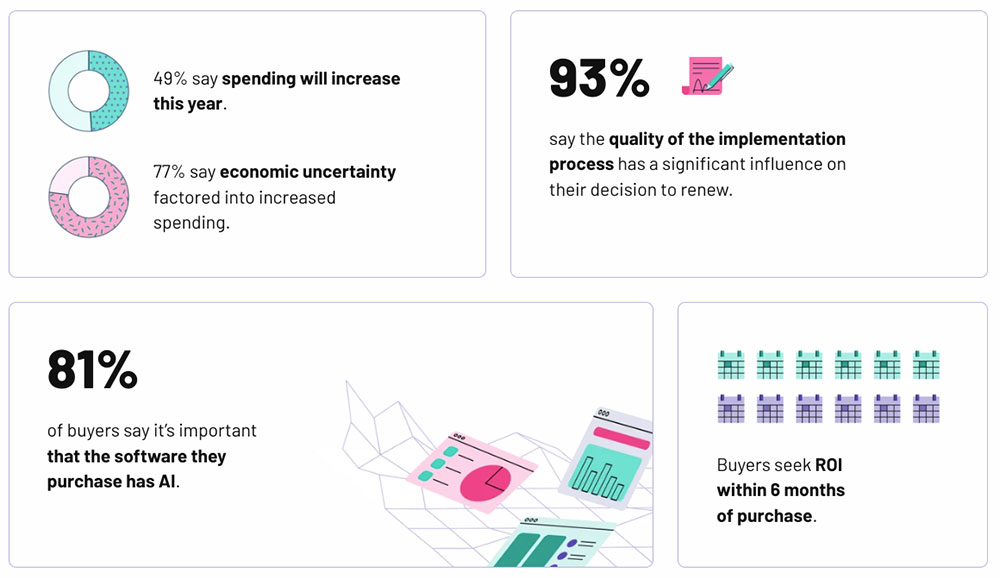Research and software marketplace firm G2 in June released its annual software buyer behavior report, “The Value-Driven Buyer,” finding that despite doom and gloom predictions around tech markets and budgets, businesses see a positive outlook among global companies buying software this year.
Artificial intelligence is reshaping the entire software landscape as buyers turn to AI to extract more value from their software purchases. It will drive legal teams to be increasingly involved in software purchases.
The global survey by G2 reveals the latest insights and trends based on responses from over 1,700 B2B software decision-makers. One of the key findings is that even in the face of today’s economic challenges, companies are continuing to invest in technology to grow their businesses.”
Notably, businesses facing pressures to show results within six months are urging vendors not just to tell them how their offerings can drive value but to show them. A key finding is that 86% of buyers leave InfoSec teams out of the purchasing processes citing pressure to deliver results quickly.
This latest software buying report shows little change in buyers’ spending outlook from last year despite the economic environment. The outlook for software spending in 2024 is even brighter. But sellers face challenges as buyer expectations and scrutiny grow.
“As buyers look for fast, easy solutions, it will be more important than ever for software vendors to think strategically about their ability to integrate with other tools, how they educate prospects along their journey and can provide helpful, efficient training during implementation,” said Chris Voce, vice president of market research at G2.
Top 3 Software Buying Trends 2023-2024
In current conditions marked by economic unpredictability, pressure on vendors, evolving buyer expectations, and a growing emphasis on AI, these trends emerge among software buyers:
Buyers predict increased software and technology spending despite an uncertain economic environment. Nearly half (49%) of buyers predicted spending would increase this year. Only 9% said it would decrease. Seventy-six percent of those who said spending would increase noted that economic uncertainty was a factor in the change, compared to 80% who said spending would decrease.
The outlook for software spending in 2024 is even brighter. More than half (55%) said spending will increase, and just 6% say it will decrease next year. Responses projecting next year’s performance were almost the same as stated for this year. Seventy-five percent saw a spending increase despite economic uncertainty. That compared to 78% of those predicting a spending decline.
Software buyers trust AI tech and prioritize its functionality in their software purchases. A large majority (81%) of respondents said it is important or very important that the software they purchase moving forward has AI functionality. Only 4% said AI functionality is not important at all. Again, a nearly identical 78% trust the accuracy and reliability of AI-powered solutions. Less than 2% say they do not trust it at all.

Source: 2023 G2 Software Buyer Behavior Report
AI Becoming Foundational
Researchers say the hype around generative AI has spurred a genuine frenzy of businesses looking to secure a competitive advantage. Buyers trust AI-powered solutions, giving a competitive advantage to any AI-powered product.
That response to AI as a product selling point surprised Voce. He noted that AI capabilities are driving more aggressive software spending.
“Companies are willing to spend on AI despite economic uncertainty,” he told the E-Commerce Times. “AI functionality is becoming paramount for businesses, even amid wide skepticism surrounding AI use.”
The report made clear that software buyers intend to increase their AI spending by 60% next year, with 72% of software buyers involved in AI purchases over $100,000.
“This underscores the explosive growth we can anticipate AI software products to experience in 2024 — beyond what we have already seen this year. It also indicates that any software vendor building AI functionality into their offerings will have a competitive advantage going forward.”
Unsanctioned Software Purchases Will Grow
With AI cemented as the new software selling point, legal teams will increasingly be involved in business software purchases, observed Voce. He noted that 84% of respondents said their IT department is responsible for security or privacy assessments when it comes to evaluating software.
“Forty percent say their legal department is involved, and we expect this to spike in the coming months and years as businesses will be wary of how their data is used and the accountability for the output of generative AI solutions,” he cautioned.
Unofficial IT practices will happen as well. Software buyers stick to business processes. But the pressure to deliver results causes shadow IT, Voce added.
Eight out of every 10 respondents (80%) said they have an official buying process in place for purchasing software. Although they acknowledged that business pressures still steer changes in behavior.
“Those who said they have purchased shadow IT — 87% of mid-size and 93% of enterprise organizations — did so because they needed to move quickly,” Voce said.
Software Buying Priorities by Business Size
Value, scalability, and ease are top considerations for software buyers. However, priorities shift based on company size.
The survey found that small businesses tend to prioritize ease of use and ease of implementation. Enterprise and medium-sized companies focus on solutions that will keep up with their growth and rank scalability as the third most important criterion when selecting new software.
Solutions to work together without added complexity are key. Ease of integration is being prioritized over the cost of software, according to Voce.
“Eighty percent of our respondents say it’s important that the software they buy integrates to their existing solutions,” he added.
However, the report did not delve into buying preferences for proprietary over open-source software since the survey did not address that aspect of business software purchased.
Vendors Must Hit a 6-Month Results Window
Business value is at the heart of software buyer decisions, according to Voce. The survey of global software buyers confirmed that buyers are still opening their budgets for software investments that they feel can help create value for their businesses.
“However, vendors vying for a piece of that increased spending still face significant roadblocks. Value is at the heart of buyers’ business goals and shapes the decisions they make,” he said.
Vendors are on the hook to show quick value. Of respondents who anticipate software spending to increase in 2024, the necessity to realize an ROI within six months is the most important consideration during the purchase process, insisted Voce based on respondent feedback.
























































Social Media
See all Social Media